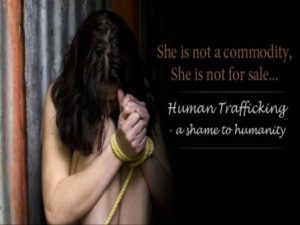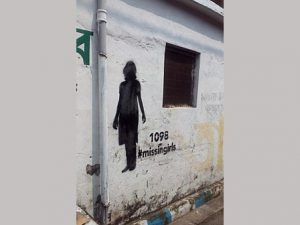Human Trafficking Flexes its Muscles Amid the Pandemic
COVID-19 pandemic offers an opportunity for all of us to look at deeply entrenched inequalities in our economic development model, which are feeding marginalisation, gender-based violence, exploitation and trafficking of all sorts.

Trafficking in persons (TIP) is one of the most shameful facets of the modern world. As a criminal act, it is an egregious human rights violation. TIP is a US$ 9 billion industry, and is estimated to be the fastest growing criminal enterprise of the 21st century. Being a signatory and ratifying the Palermo Protocol, India has amended its penal code in 2013, which explicitly prohibits trafficking of persons for purposes of prostitution. The POCSO ACT, 2012 further prohibits various sexual offences committed against children under 18 years of age. Despite such laws in place, the country is estimated to have 14 million victims of human trafficking, which includes victims of sex trafficking, bonded labour, domestic servitude, child labour and forced marriages. India acts both as a destination and a transit place for labour and sex trafficking. While 90 per cent of trafficking in the country occurs domestically (intra-state or inter-state), 10 per cent occurs across its national borders.
Also Read : Need For Breaking The Deafening Silence On Re Trafficking
Influencing Factors
The most definite primary factors contributing to the rising numbers of trafficking in India, or any such developing country, are the weak legal landscape and implementation along with factors like gender discrimination, poverty, lack of access to education, social practices, globalisation, lack of economic opportunities and growth. Beyond these, there are certain secondary causes like low employment prospects for people, lack of awareness of women’s rights, marginalisation of females, a highly patriarchal society and cultural ideas like dowry and violence prevailing in our society. Lack of opportunities in the highly patriarchal society is a major cause of trafficking. In 2012, only 43 per cent of women worked on a regular wage or in salaried positions. The victims are generally of a very young age, illiterate and belong to impoverished families from rural backgrounds. In males it is generally seen that trafficking is tied with forced labour especially to pay off the debts which is widely seen in the Indian social structure.
Effect of COVID-19
COVID-19 pandemic has been affecting the lives of everyone forcing them to adapt to the ‘new-normal’. Likewise the criminals involved in trafficking have adjusted their strategies and business models accordingly. Economic and social inequalities – the root causes of human trafficking – have notched up a level due to the pandemic situation. Martin Wolf recently stated that the current economic crisis due to COVID-19 is clearly the greatest since Great Depression in both size and intensity. The restrictions on movement caused due to the corona virus pandemic in the form of lockdowns are creating a major obstacle for escapes and finding help for these victims. There exists a threat of abuse or neglect by the captors of the victims who are still in confinement. We can already witness a surge in the levels of domestic violence, which is a worrying factor. In the times, where individuals are prioritising their actions towards limiting the spread of corona virus, it acts as an aid to these traffickers to hide their actions and makes the victims’ identification and referral to protection platforms a huge challenge.
Due to the confinement at homes the access to assistance and support from related NGOs or government schemes, in-person counselling, representation and legal aid become difficult.

The victims are also highly exposed to contacting the virus, since they are less equipped to prevent it and there exists a lack of healthcare to ensure their recovery. Violence, especially against children, along with sexual abuse is much more rampant in the current times since children are being forced on streets in search of food and income bringing them to the forefront of the risk of both infection from the virus and exploitation.
Virtual Exploitation: Cybersex Trafficking
The modern day slavery is on a rise due to closure of schools, which makes children vulnerable to online sexual predators. Virtual world is the platform for learning and socialising widely used today. There is a spike in the child sexual exploitation material on the internet, which acts like a profitable business for huge tech platforms. The pandemic is giving a push to such new materials, which are created in exchange for remuneration or a payment. Live streaming – the new modus operandi of offenders – is becoming a platform for on-demand sexual abuse. There is this idea of impunity from a perpetrator’s point of view and the assumption of anonymity, which emboldens them to force and exploit children. While the barriers for perpetrators are extremely low, the barriers of recovery for these victims are extraordinarily high exposing them to the evils of the world through a screen.
There is a high possibility that once the lockdown if lifted and normal activities are resumed, factory owners might opt for employing cheap labour. The desperate and vulnerable workers will contribute to this massive pool of cheap labour, since they cannot possibly negotiate their wage terms with the employers. Children will be trafficked to work where they would be paid meagre or no wages at all while facing extreme physical, mental and sexual torture.
Mechanisms to Combat Trafficking
Also Read : Human Rights Experts Urge For Make In India And Skill India Responsibly
There are many programmes and schemes already in place which focus on protecting the vulnerable like the Integrated Anti-Human Trafficking Units (IAHTUs), which has been set up in more than 600 districts and are 226 in number with an allocation of Rs 832 million as funds; Swadhar Programme developed by the Ministry of Women and Child Development providing over 200 shelters for the victims of sex trafficking; Ujjawala Programme introduced in 2007 with over 6350 beneficiaries; and Child Line Services, the toll free number 1098, which is available to all children in distress and is operational in 372 cities. The Immoral Trafficking Prevention Act 1956, Bonded Labour Abolition Act 1976, Child Labour (Prohibition and Regulation Act) 1986 and the Section 370 of Indian Penal Code, 1860 have provisions for prevention of trafficking and punishments for all such acts.
The problem does not lie in the formulation of laws, but on the implementation front.
The Trafficking of Persons (Prevention, Protection and Rehabilitation) Bill 2018 must be re-visited by the Parliamentary Standing Committee since it lacks clarity, as the approach is scattered across various laws and seems to be inconsistent with the objectives. Further, it is not comprehensive also. Even UN has raised concerns over the provisions of the Bill being ambiguous and for including penal activities not necessarily connected to trafficking. The burden of proof of the offence also lies on the victim, and so it creates a high bar to claim immunity and defeats the very purpose of the provision.
The COVID-19 pandemic offers an opportunity for all of us to look at deeply entrenched inequalities in our economic development model, which are feeding marginalisation, gender-based violence, exploitation and trafficking of all sorts. The law enforcement officials must remain vigilant and ramp up the relief programmes. There is a dire need to make parents and caregivers aware about the situation, since it is the youth which is often targeted. It has been a trend for traffickers to seek out for children with behavioural problems, low self-esteem, history of abuse or neglect, poverty or substance abuse. It becomes critical for parents to build a healthy relationship with their children, explain them about gender roles and stereotype threats early, talks about sexual education and the importance of consenting to such acts. These are some of the ways to protect and prevent any sort of cybercrimes. Businesses can provide internships or training to the survivors of trafficking and college students too can take action to raise awareness or take up research work in the field.
